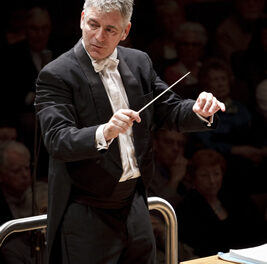Bucking a national trend of declining recitals, Raleigh is the site of a new festival exploiting the historical links among the diplomatic efforts of the virtuoso pianist/statesman Ignacy Jan Paderewski (1860-1941), N.C. native Josepheus Daniels, who was Secretary of the Navy for President Woodrow Wilson, and Mary Lee McMillan, long-time resident of Raleigh who served as secretary to Helena Paderewska. The festival consisted of an introductory lecture by Mark Fountain, its president, and three recitals, of which the one under discussion here was the first.
Besides being a pianist and composer, Paderewski was also a politician and advocate for Polish independence in the wake of World War I. Multiple venues throughout the city are being used for this first Annual Paderewski Festival. There were not many empty seats in the intimate Carswell Recital Hall at Meredith College. This inaugural concert featured a fascinating introduction by Adam Wibrowski, festival artistic director, followed by a recital by Durham native Andrew Tyson.
A pair of selections from Paderewski’s six Humoresques de Concert, Op. 14, aptly opened the recital. Robert Schumann first used the term “humoresque” for free, whimsical, or fanciful composition. Paderewski’s Minuet in G, Op. 14, No. 1, is the composer’s best known work, having been widely performed and recorded by the composer and his contemporaries. It has a wonderfully insouciant opening. It shares frequent crossed hands and cascading arpeggios with Intermezzo Polacco, Op. 14, No. 5, which has wide ranging dynamics.
The music of Fryderyk Chopin (1810-49) has been an integral part of Tyson’s career, and he has been equally sympathetic to it. The mazurka was originally a heroic Polish dance with a triple meter rhythm with the accent on the second or third beat. Chopin raised these dances to an art form, creating little stories in music reflecting a wide-ranging palette of emotions. These contain some of the composer’s most adventurous harmonic innovations. The four Mazurkas of Op. 30 (Nos. 1 in C Minor, 2 in B Minor, 3 in D-flat, and 4 in C-sharp Minor) were heard next.
Two characteristic Chopin selections, the Polonaise in C-sharp Minor, Op. 26, No. 1, and the Ballade No. 3 in A-flat, Op. 47, brought the first half of the concert to a conclusion.
After the intermission there was a rare chance to hear Tyson in 20th century advanced works. The French composer Henri Dutilleux (1916-2013) is one of my favorites because of his complex and colorful orchestral scores, including a Cello Concerto, “Tout un monde lointain,” written for Mstislav Rostropovich.
The composer’s Three Preludes (1973, 1977, and 1988, respectively) are a microcosm of Dutilleux’s formal and expressive approach; Tyson played the first two of them. According to Richard Whitehouse’s program notes for Hyperion, “Prelude No. 1, D’ombre et de silence, looks back to the rarefied manner of Debussy’s late piano music in its succession of harmonies” that seem to melt into each other. Prelude No. 2, Sur un même accord,” is more reductive…, a single chord sufficing for this study in the possibilities of keyboard resonance as a means of achieving formal continuity.”
This concert ended with Études Symphoniques, Op. 13 (1834), one the most successful large-scale works by Robert Schumann (1810-56). It is effectively a massive series of variations built around a simple theme. Despite vivid contrasts between the variations, they still hang together as a unified piece. The theme is sometimes used melodically, buried within the bass line, or handled even less obviously.
Tyson’s command of keyboard articulation, tone color, and dynamics was spectacular. All but the Dutilleux preludes were played without reference to a score. He effectively contrasted the stylistic differences between the Polish composers Paderewski and Chopin. Tyson’s Chopin has always been superb. The Schumann, with its many diverse variations held together within an overall conception, capped the recital magnificently..
Prolonged and enthusiastic applause was rewarded with a real rarity for the left hand alone that was breathtaking to hear and see performed. It did not seem to match any of the commissions made for Paul Wittgenstein, the WW I veteran brother of Ludwig. Tyson later told me it was an etude for the left hand by Alexander Scriabin.
Remaining festival concerts are shown in the sidebar.











